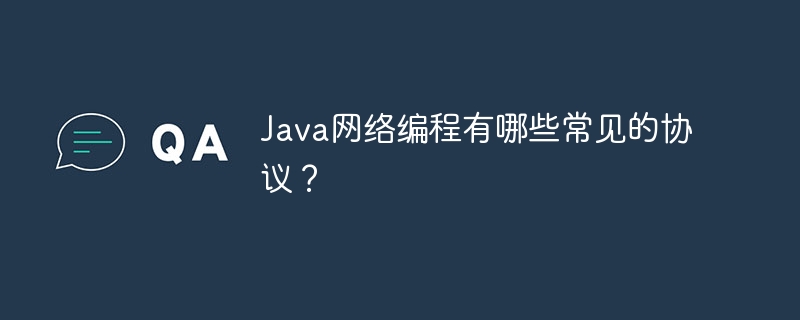What are the common protocols for Java network programming?
Java Commonly used protocols in network programming include: TCP/IP: used for reliable data transmission and connection management. HTTP: Used for web data transfer. HTTPS: A secure version of HTTP that uses encryption to transmit data. UDP: For fast but unstable data transfer. JDBC: used to interact with relational databases.

Common protocols in Java network programming
Network programming is an important part of Java development, which enables applications to Communicate over the network. In Java network programming, there are several common protocols used to implement data transmission and processing.
1. TCP/IP
TCP/IP (Transmission Control Protocol/Internet Protocol) is a protocol stack used for reliable transmission of data on the network. It provides streaming data transfer and connection management capabilities to ensure data reaches its destination in the correct order.
2. HTTP
HTTP (Hypertext Transfer Protocol) is a protocol used to transfer data on the Web. It is used to request and respond to web pages, images, and other files.
3. HTTPS
HTTPS is a secure version of HTTP that uses TLS/SSL encryption to transmit data. It is often used to protect sensitive information such as passwords and credit card numbers.
4. UDP
UDP (User Datagram Protocol) is a connectionless protocol used for unstable transmission of data. It is more suitable for real-time applications such as video streaming and gaming.
5. JDBC
JDBC (Java Database Connectivity) is a Java API for interacting with relational databases. It allows Java programs to connect to the database, perform queries and update data.
Practical case: Use TCP/IP to create a simple chat server-client
The following is a program to use TCP/IP to create a simple chat server-client Example:
Server.java
import java.io.*;
import java.net.*;
public class Server {
public static void main(String[] args) throws IOException {
// 创建服务器套接字并监听端口
ServerSocket serverSocket = new ServerSocket(1234);
// 无限循环,等待客户端连接
while (true) {
// 接受客户端连接
Socket clientSocket = serverSocket.accept();
// 创建输入流读取客户端消息
BufferedReader in = new BufferedReader(new InputStreamReader(clientSocket.getInputStream()));
// 创建输出流发送消息到客户端
PrintWriter out = new PrintWriter(clientSocket.getOutputStream(), true);
// 读取客户端消息并打印到控制台
String message = in.readLine();
System.out.println("Received message: " + message);
// 向客户端发送应答消息
out.println("Hello from server!");
// 关闭套接字和流
clientSocket.close();
in.close();
out.close();
}
}
}Client.java
import java.io.*;
import java.net.*;
public class Client {
public static void main(String[] args) throws IOException {
// 创建客户端套接字并连接到服务器
Socket clientSocket = new Socket("localhost", 1234);
// 创建输出流发送消息到服务器
PrintWriter out = new PrintWriter(clientSocket.getOutputStream(), true);
// 创建输入流读取服务器消息
BufferedReader in = new BufferedReader(new InputStreamReader(clientSocket.getInputStream()));
// 向服务器发送消息
out.println("Hello from client!");
// 读取服务器应答消息并打印到控制台
String message = in.readLine();
System.out.println("Received message: " + message);
// 关闭套接字和流
clientSocket.close();
in.close();
out.close();
}
}The above is the detailed content of What are the common protocols for Java network programming?. For more information, please follow other related articles on the PHP Chinese website!

Hot AI Tools

Undresser.AI Undress
AI-powered app for creating realistic nude photos

AI Clothes Remover
Online AI tool for removing clothes from photos.

Undress AI Tool
Undress images for free

Clothoff.io
AI clothes remover

AI Hentai Generator
Generate AI Hentai for free.

Hot Article

Hot Tools

Notepad++7.3.1
Easy-to-use and free code editor

SublimeText3 Chinese version
Chinese version, very easy to use

Zend Studio 13.0.1
Powerful PHP integrated development environment

Dreamweaver CS6
Visual web development tools

SublimeText3 Mac version
God-level code editing software (SublimeText3)

Hot Topics
 Square Root in Java
Aug 30, 2024 pm 04:26 PM
Square Root in Java
Aug 30, 2024 pm 04:26 PM
Guide to Square Root in Java. Here we discuss how Square Root works in Java with example and its code implementation respectively.
 Perfect Number in Java
Aug 30, 2024 pm 04:28 PM
Perfect Number in Java
Aug 30, 2024 pm 04:28 PM
Guide to Perfect Number in Java. Here we discuss the Definition, How to check Perfect number in Java?, examples with code implementation.
 Random Number Generator in Java
Aug 30, 2024 pm 04:27 PM
Random Number Generator in Java
Aug 30, 2024 pm 04:27 PM
Guide to Random Number Generator in Java. Here we discuss Functions in Java with examples and two different Generators with ther examples.
 Weka in Java
Aug 30, 2024 pm 04:28 PM
Weka in Java
Aug 30, 2024 pm 04:28 PM
Guide to Weka in Java. Here we discuss the Introduction, how to use weka java, the type of platform, and advantages with examples.
 Armstrong Number in Java
Aug 30, 2024 pm 04:26 PM
Armstrong Number in Java
Aug 30, 2024 pm 04:26 PM
Guide to the Armstrong Number in Java. Here we discuss an introduction to Armstrong's number in java along with some of the code.
 Smith Number in Java
Aug 30, 2024 pm 04:28 PM
Smith Number in Java
Aug 30, 2024 pm 04:28 PM
Guide to Smith Number in Java. Here we discuss the Definition, How to check smith number in Java? example with code implementation.
 Java Spring Interview Questions
Aug 30, 2024 pm 04:29 PM
Java Spring Interview Questions
Aug 30, 2024 pm 04:29 PM
In this article, we have kept the most asked Java Spring Interview Questions with their detailed answers. So that you can crack the interview.
 Break or return from Java 8 stream forEach?
Feb 07, 2025 pm 12:09 PM
Break or return from Java 8 stream forEach?
Feb 07, 2025 pm 12:09 PM
Java 8 introduces the Stream API, providing a powerful and expressive way to process data collections. However, a common question when using Stream is: How to break or return from a forEach operation? Traditional loops allow for early interruption or return, but Stream's forEach method does not directly support this method. This article will explain the reasons and explore alternative methods for implementing premature termination in Stream processing systems. Further reading: Java Stream API improvements Understand Stream forEach The forEach method is a terminal operation that performs one operation on each element in the Stream. Its design intention is






